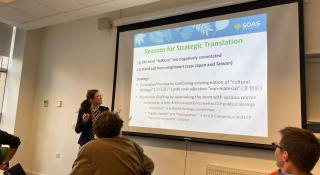
Breadcrumbs navigation
How do non-democratic governments engage citizens in policy-making? Introducing ‘participatory authoritarianism’
Catherine Owen discusses her new article published in the October 2020 issue of BISA journal Review of International Studies. It explores the way in which Russian and Chinese governments have rearticulated global trends towards active citizenship and participatory governance, and integrated them into pre-existing illiberal political traditions.
It is widely accepted that the transformation of public administration in democracies, away from the large bureaucracies of the 20th Century and towards regulatory and arms’ length governance, has produced new modes of interaction between local governments and citizens. In regulatory states, citizens are encouraged to take a far more active role in governance, including choosing and limiting their welfare needs, participating in local decision-making processes and assisting in service delivery. The concept of ‘active citizenship’ is often applied to this new relationship between society and the state. However, the process of fragmentation and integration of national public sectors into global financial systems that underlies this transformation is not limited to democracies, in which the idea of civic engagement is considered a key component of liberal society. Non-democratic states are also incorporating elements of marketized governance into their state bureaucracies – and new modes of citizenship are emerging there as well.
This development raises several important questions for state-society relations in non-democracies. How do authoritarian governments manage the changes in the nature of state-society relations that accompany marketisation? How is the production of ‘active citizenship’ curated in countries that have typically provided minimal space for civic engagement? A British Academy Postdoctoral Fellowship allowed me to explore this question in the case of Russia and China, at the local level where the interactions between citizens and state are most visible. I conducted qualitative interviews with local officials and citizen users of participatory mechanisms, studied speeches and official pronouncements by political leaders about the appropriate role of citizens in governance, and examined the two countries’ legislation governing participatory mechanisms. The first article based on this research, out now in the current issue Review of International Studies (volume 46, number 4), proposes one explanation of how local authoritarian governments achieve this on the ground, namely through practices of participatory authoritarianism.
From bureaucratic transformation to civic participation
Until 1970s, public administration around the world was characterised by so-called ‘command and control’ bureaucracies, which supplied cradle-to-grave social security directly to citizens. Perhaps the most extreme examples of this were operated by pre-reform Russia and China’s state socialist bureaucracies. In China, the ‘iron rice bowl’ provided education, housing, healthcare and pensions through the work unit (danwei), while a similar system in Russia has been dubbed its ‘wheat-based version’. This comprehensive welfare provision from the state was accompanied by citizens’ mass participation in political life: the Communist Parties in both states greatly expanded and localised Russian and Chinese citizens’ experience of the state. However, in both pre-reform Russia and China, civic participation was seen as the execution of centrally determined policies, not the co-production of policy by citizens and officials. Thus, citizens should be educated in central Party policy and then mobilised to carry it out.
From the 1970s, Western governments began to consider the state no longer best placed to provide public goods directly to citizens and introduced mechanisms into the state apparatus. Processes of privatisation, outsourcing, managerialism and competition for government funding replaced the command and control bureaucracies with types of regulatory states. In regulatory states, government agents deploy decentralised, fragmentary agencies to monitor and oversee functions performed by third parties. In Russia and China, the shift towards regulatory statehood began with the reform agendas of Mikhail Gorbachev and Deng Xiaoping and accelerated after the Asian financial crisis in 1997.
Around the world, this process of marketisation has transformed in the way in which governments conceive of the role of citizens in the governing process. Citizens are increasingly seen as ‘consumers’ of government services, and must be able to make rational and informed choices about their needs. Their preferences must be accessed by policymakers to ensure services are developed to meet those needs. Further, since the fragmentation and decentralisation of formerly centralised state agencies have resulted in private businesses and third sector organisations delivering frontline services, the inclusion of citizens and non-state service providers into policy processes has become an important means for policymakers to garner the requisite knowledge. In short, the role of the citizen in society has transformed as the role of the state shifted away from direct service provision and towards regulation.
Thus, local civic participatory mechanisms that enable citizens to provide input into policy-making have become more prevalent in states around the world. Local governments are experimenting with a wide range of tools that aim to aid policy-making, foster a sense of community among citizens and legitimise local government decisions. These range from participatory budgeting initiatives and community engagement organisations to new public consultative or deliberative mechanisms, both in-person and online.
Practices of participatory authoritarianism
Much research has been conducted on civic engagement in democracies, but this trend in non-democracies remains comparatively under-explored. Indeed, the idea that authoritarian states could adopt such an agenda appears anathema to our understanding of how authoritarian governments rule. The bulk of literature on authoritarian governance suggests that citizens in such states are either lured by ‘carrots’ or coerced by ‘sticks’ into cooperating with the authorities. My research shows that citizens in Russia and China’s urban centres have multiple opportunities to engage voluntarily with local officials, but that their participation is curtailed and often undermined. Neither completely manufactured, nor fully independent, local civic participatory mechanisms in Russia and China’s authoritarian polities provide a limited opportunity for citizens to shape policy processes.
I have termed this participatory authoritarianism. This is defined as ‘a set of practices by local governments in non-democratic states undergoing processes of bureaucratic marketisation that establishes avenues for citizens to engage voluntarily in policy processes, while simultaneously deliberately limiting, controlling, or undermining the extent and impact of this engagement’ (p. 420). These practices manifest themselves both during the process of organising a participatory event and in the way the event’s conclusions are handled by the authorities. First, officials widen citizens’ participation in policy processes, while either vetting potential participants to ensure access only to compliant individuals or ejecting participants during the event for airing inappropriate opinions. Second, officials conduct a participatory event but subsequently overlook the conclusions, either by privately making the relevant decisions beforehand or drastically watering down any transformative potential in the follow-up legislation.
Practice one: Limiting participation itself
The first practice involves ensuring that only those individuals likely to support the government agenda engage in the participatory event. One respondent in Russia lamented, ‘The method of selection is to a large extent controlled. Firstly people don’t choose the candidates they want, but the candidates they are told to choose … Or they choose the people whose names they recognise. I don’t really believe in the selection process.’ Local activists working with a specific cause (for instance, accessibility for disabled people or environmentalism) are often invited to make their case in local public policy fora, but if local officials consider their input as too hostile or, in the case of Russia, opposition-oriented, the invitation may be withdrawn. Several respondents in both countries articulated suspicions that some participants were in fact local government plants intended to disrupt the event or bring about the outcomes desired by the government. In China, respondents explained that participants in deliberative mechanisms are nearly always CCP members and are monitored by local officials before being invited to join. In both cases, respondents were able to recall numerous individuals whose invitation to participate was withdrawn after they aired opinions deemed overly critical of the local authorities.
Practice two: Limiting the results of public deliberation
The second practice entails local officials holding a participatory event, but subsequently de-emphasising its results, for example by privately making the relevant decisions beforehand, drastically watering down any transformative potential in the follow-up legislation or using a heavily engineered participatory event to justify broader public policy decisions. One China-based interviewee explained, ‘Why do governments hold participatory activities? They want to show that the public supports their activities. People will complain less if they are invited to talk to the government.’ In participatory budgeting initiatives, local officials in both Russia and China reserve the right to disqualify projects considered inappropriate. In the case of Russian participatory institutions, citizen members are under no illusions regarding the limitations of their influence, believing they have leverage in some relatively marginal or non-controversial areas but not in others considered to be of strategic importance or of current political debate. In both states, these new consultative initiatives are advisory in nature, meaning that local governments can easily disregard inconvenient recommendations. Yet citizens are not always ignored – research on participatory institutions in both states demonstrate that they do have limited impact on policy outcomes. One member of a participatory body in Russia recalled, ‘There have been three instances so far in the Public Budget Council when they took the societal experts’ advice either in full or in part.’ Since the council’s term is normally three years, this would amount to the government adopting citizens’ recommendations once a year.
Conclusion
My article demonstrates that types of active citizenship in which citizens may choose to engage with local officials are important in non-democratic states like Russia and China. Russian and Chinese leaders have embraced the notion of civic participation, incorporating it into broader theories and ideologies of governing and operationalising it at the local level through the creation of new fora that bring government officials and citizens together. This shows that participatory governance is not the preserve of democracies: in democratic and non-democratic regimes alike, voluntary practices of civic participation enacted by active and engaged citizens are considered essential for local governance in an era of late capitalism, as market-oriented political subjectivities are produced through interactions between the individual and the local state. However, in Russia and China this process is heavily curated and, while not completely staged, limits and undermines the democratising potential of citizen participation. Thus, authoritarian governments can claim to both domestic and international audiences that they provide space for citizen input while minimising any potential threat to regime stability.
So, what’s next for this research agenda? While this article focusses primarily on citizen participation in policy-making, my book manuscript expands the analysis to include participation in policy delivery. While the article shows that Russia and China operate a comparable approach to enhancing citizen engagement with policy-makers, my book shows that when it comes to policy delivery, the two countries exhibit substantial differences. Implementation requires high levels of investment in necessary infrastructure, and Russia’s public sector has been ravaged by austerity and poor policy decisions, while in China local governments have the freedom and incentives to source their own funds and develop policy innovations. This means that local governments in China are able to create opportunities for citizens to participate in government-led implementation activities; in Russia, it is often committed volunteers or employees of non-governmental organisations that provide essential services. The effect of this is that the Chinese Communist Party retains far greater control of citizen engagement, while in Russia citizen activists are more likely to be disillusioned and highly critical of the government. These findings will be elucidated in detail in my first monograph – watch this space!


